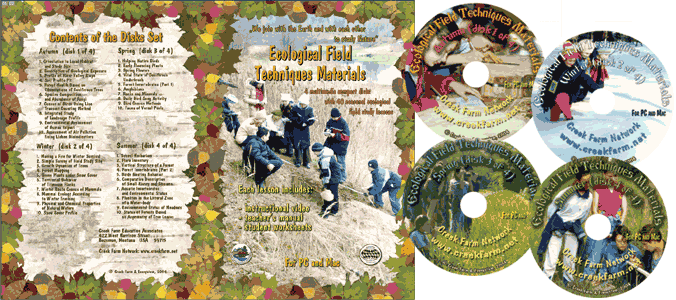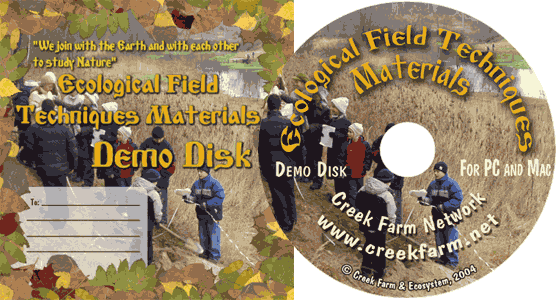|
| Our Field Ecology Center published more than
180 methodical materials for nature studies. Some of them are in English: |
|
|
|
Study of the Ecology of Early Flowering Plants
© Alexsander S. Bogolyubov,
Russia, 2002
© Michael J. Brody, USA,
2003
 This manual is devoted to studies of early flowering
plants. The manual describes important biological peculiarities of these plants, the
procedure for assessment of their distribution and numbers within the area under study as
well as methods for the recording of observation data and presentation of studies results. This manual is devoted to studies of early flowering
plants. The manual describes important biological peculiarities of these plants, the
procedure for assessment of their distribution and numbers within the area under study as
well as methods for the recording of observation data and presentation of studies results.
This field study has instructional video
featuring real students conducting the ecological field techniques in nature. Each video
illustrates the primary instructional outcomes and the major steps in accomplishing the
task including reporting the results.
Introduction
Peculiarities of early flowering plants
Early flowering plants are the plants of early spring flora, which blossom right after
snow cover melts away. In the central part of Russia, these plants blossom in April (in
some warm years, starting from the end of March) until mid-May.
What is the biological sense of such early blossoming for this group of plants?
The first and the most important reason is sunlight. It is well known that photosynthesis
takes place in photosynthetic (green) organs of plants in sunlight, when organic
substances, carbohydrates, are formed out of inorganic substances (water and
carbon dioxide). Plants use carbohydrates for their growth and development. Thus, a
sufficient amount of sunlight is a necessary condition for the normal development of
plants.
Forests located in the temperate climatic zone are richest in sunlight in early spring.
Trees and bushes are not covered with foliage yet and nothing prevents the sunlight from
freely reaching the ground.
This factor is the main reason that many plant species have in the course of their
evolution УchosenФ early spring to blossom. That is why most early flowering plants
are found in deciduous, especially broad-leaved, УdarkФ forests.
There is another reason that plants use the УtransparencyФ of spring forests that
are free from leaves. Pollination occurs easier in a spring forests where there is
no foliage. It affects wind-pollinated early flowering plants, such as
well-known birches (different representatives of the Betula genus), aspen (Populus
tremula), alder-trees (speckled and black alder Ц representatives of Alnus
genus), hazel or nutwood (Corylus avellana). Nothing prevents the
wind from transferring pollen from the male flowers of these plants (which are combined in
polliniferous catkins) onto female flowers, which consist of small sticky
pistils in early spring. When leaves on trees and bushes come out, they will prevent the
wind from moving freely in the tree crowns.
Insect-pollinated plants also use this season in their own way. They first
attract insects with their bright flowers of yellow, blue and pink. Flowers of low-growing
plants are poorly seen in the twilight of summer forest (incidentally, the flowers of
plants found in the lower forest layer and that blossom in summer Ц oxalis, trientale,
may-lily and others Ц are white in color, as it stands out the most
brightly under conditions of insufficient illumination).
One more reason for the early flowering of plants is the availability of moisture.
The soil is saturated with moisture after the snow melts, and the moisture is necessary
for the normal development of plants.
Ephemeroids
Favorable spring factors (sufficient illumination and moisture) are better used by
small plants, which belong to a group called ephemeroids. It is the most
specific group of early flowering plants, which is narrowly adapted to early blossoming.
The word УephemeralФ is associated with something beautiful, but passing, or
short-lived. It is ascribed to early spring ephemeroids in full. They are remarkable for
their exceptional "speed," they appear right after the snow melts away and
quickly develop despite the spring coolness. They blossom a week or two after they have
appeared, and in two or three weeks they have fruit with seeds. The plants themselves
begin to...
This was only the first page from the manual and its full version you can see in the
Ecological Field Studies Techniques Video 4CD Set:
It is possible to purchase the complete set of 40 seasonal Ecological Field
Studies Techniques Video (in mpg format) in an attractive 4 compact disk set.
These compact disks are compatible with Mac and PC computers.
The videos are suitable for individual student or whole class instruction. To purchase the complete 4CD set
write to ecosystema1994@yandex.ru in a free form.

Ecological Field Studies Demo Disk:
We also have a free and interesting demonstration disk that explains our ecological field studies approach.
The demo disk has short excerpts from all the seasonal field study videos as well as sample text from all the teacher manuals.
The disk has an entertaining automatic walk through which describes the field study approach and explains how field studies meet education standards.
You can also download the Demo Disc from ecosystema.ru/eng/eftm/CD_Demo.iso.
This is a virtual hybrid (for PC and Mac computers) CD-ROM image (one 563 Mb file "CD_Demo.iso").
You can write this image to the CD and use it in your computer in ordinary way.
You also can use emulator software of virtual CD-ROM drive to play the disk directly from your hard disk.

|







